Questions with Answers, Solution | Life Mathematics | Chapter 4 | 8th Maths - Exercise 4.3 (Compound Interest) | 8th Maths : Chapter 4 : Life Mathematics
Chapter: 8th Maths : Chapter 4 : Life Mathematics
Exercise 4.3 (Compound Interest)
Exercise
4.3
1. Fill in the blanks:
(i) The compound interest on ₹5000 at
12 % p.a for 2 years, compounded annually is ____________. [Answer: ₹ 1272]
Solution:

Solution 2:
Compound Interest (CI) formula is
CI = Amount − Principal
Amount = A (1 + [r/100] )n
= 5000 ( 1 + 12/100 )2 = 5000 × (112 / 100)2
= 6272
∴ CI = 6272 – 5000 = ₹
1272
(ii) The compound interest on ₹8000 at
10 % p.a for 1 year, compounded half yearly is ____________. [Answer: ₹ 820 ]
Solution:

Solution 2:
Compound Interest (CI) = Amount − Principal
Amount = P (1 + [r/100] )2n [2n as it is compounded half yearly]
r = 10% p.a, for half yearly r
= 10/2 = 5
∴ A = 8000 (1 + [5/100])2x1 = 8000 × (105 / 100)2
= 8820
CI = Amount – Principal = 8820 − 8000 = ₹ 820
(iii) The annual rate of growth in population
of a town is 10 % . If its present population is 26620, then the population 3 years
ago was_________. [Answer: ₹ 20,000]
Solution:
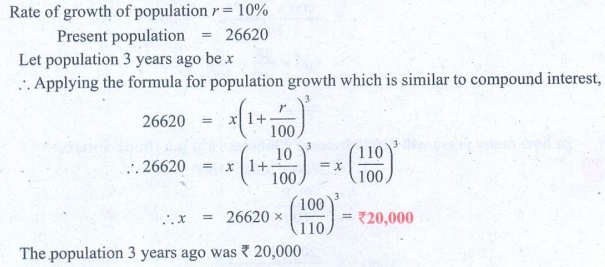
Solution 2:
Rate of growth of population r = 10%
Present population = 26620
Let population 3 years ago be x
∴ Applying the formula for population growth which is similar to
compound interest,
26620 = x (1 + [r/100])3
∴ x = 26620 = x (1 + [10/100])3
= x (110/100)3
∴ x = 26620 × (110/100)3
= ₹ 20,000
The population 3 years ago was
₹ 20,000
(iv) If the compound interest is calculated
quarterly, the amount is found using the formula __________. [Answer:  [or] A = P ( 1 + r/400 )4n]
[or] A = P ( 1 + r/400 )4n]
Solution:
Quarterly means 4 times in a year.
∴ The formula for compound interest is

A = P ( 1 + r/400 )4n
(v) The difference between the C.I and
S.I for 2 years for a principal of ₹5000 at the rate of interest 8 % p.a is ___________.
[Answer: ₹ 32]
Solution:

Solution 2:
Difference between S.I & C.I is given by the formula
CI − SI = P(r/100)2
Principal (P) = 5000, r = 8% p.a
∴ CI − SI = 5000 (8/100)2
= 5000 × 8/100 × 8/100 = ₹ 32
2. Say True or False.
(i) Depreciation value is calculated
by the formula,  [Answer: True]
[Answer: True]
Solution:
Depreciation formula is P ( 1 – r/100 )n
(ii) If the present population of a city
is P and it increases at the rate of r % p.a, then the population n years ago would
be  . [Answer: False]
. [Answer: False]
Solution:
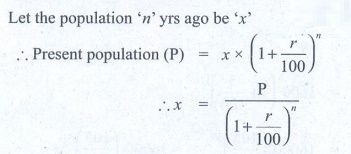
Solution 2:
Let the population 'n’
yrs ago be 'x'
∴ Present population (P) = x × ( 1 + [r/100] )n
∴ x = P / (1 + [r/100])n
(iii) The present value of a machine
is ₹16800. It depreciates at 25 % p.a. Its worth after 2 years is ₹9450. [Answer: True]
Solution:

Solution 2:
Present value of machine = ₹
16800
Depreciation rate (n) =
25%
Value after 2 years = P ( 1 + r/100
)n = 16800 (1 –
25/100)2
= 16800 × ( 1 – 1/4 )2 = 16800 × 3/4 × 3/4 = 9450
(iv) The time taken for ₹1000 to become
₹1331 at 20 % p.a, compounded annually is 3 years. [Answer: False]
Solution:
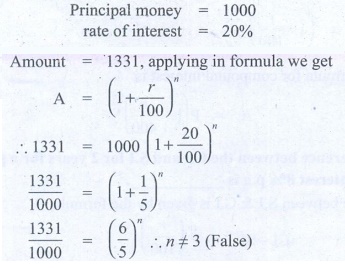
Solution 2:
Principal money = 1000
rate of interest = 20%
Amount (A) = 1331, applying in formula we get
A = (1 + [r/100] )n
∴1331 = 1000 (1 + [20/100] )n
1331/1000 = (1 + 1/5)n
1331/1000 = (6/5)n ∴ n ≠ 3 (False)
(v) The compound interest on ₹16000 for
9 months at 20 % p.a, compounded quarterly is ₹2522. [Answer: True]
Solution:
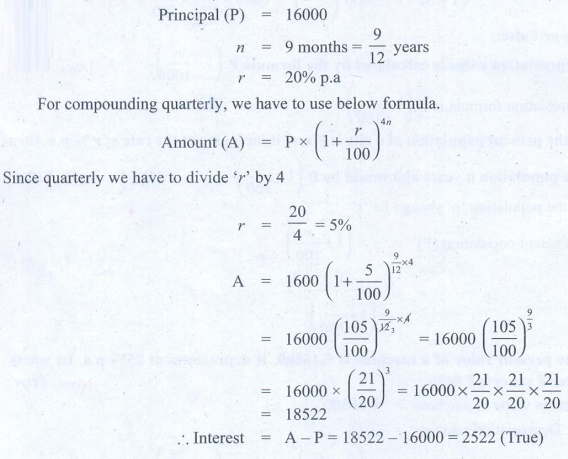
Solution 2:
Principal (P) = 16000
n = 9 months = 9/12 years
r = 20% p.a
For compounding quarterly, we have to use below formula.
Amount (A) = P × ( 1 + [r/100] )4n
Since quarterly we have to divide ‘r’ by 4
r = 20/4 = 5%
A = 16000 ( 1 + [5/100] )9/12x4
= 16000 (105/100) 9/12x4 = 16000 (105/100)
9/3
= 16000 × (21/20)3 = 16000 × 21/20 × 21/20
× 21/20
∴ Interest = A − P = 18522
− 16000 = 2522 (True)
3. Find the compound interest on ₹3200
at 2.5 % p.a for 2 years, compounded annually.
Solution:
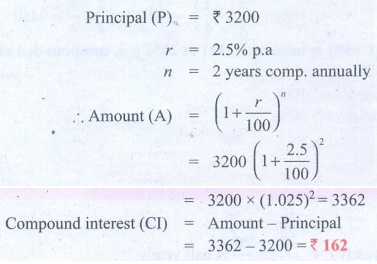
Solution 2:
Principal (P) = ₹ 3200
r = 2.5% p.a
n = 2 years comp, annually
∴ Amount (A) = (1 + [r/100] )n
= 3200 ( 1 + [2.5/100] )2
= 3200 × (1.025)2 = 3362
Compound Interest (CI) = Amount − Principal
= 3362 – 3200 = ₹ 162
4. Find the compound interest for 2 1/2
years on ₹4000 at 10 % p.a, if the interest is compounded yearly.
Solution:
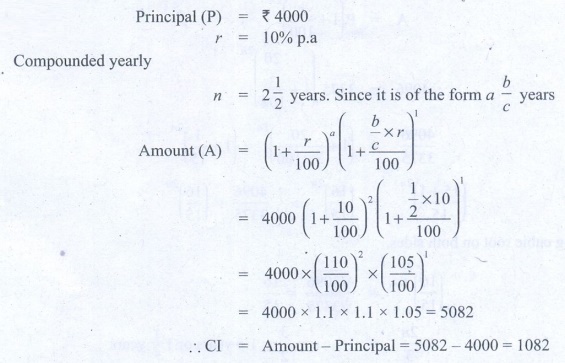
Solution 2:
Principal (P) = ₹ 4000
r = 10% p.a
Compounded yearly
n = 2 1/2 years. Since it is of
the form a b/c years
Amount (A) = (1 + [r/100]
)a ( 1 + ([b/c × r] / 100) )1
= 4000 × (1 + 10/100)2
( 1 + [ (1/2 × 10) / 100] )1
= 4000 × (110 / 100)2
× (105 / 100)1
= 4000 × 1.1 × 1.1 × 1.05 =
5082
∴ CI = Amount − Principal = 5082 – 4000 = 1082
5. A principal becomes ₹2028 in 2 years
at 4 % p.a compound interest. Find the principal.
Solution:
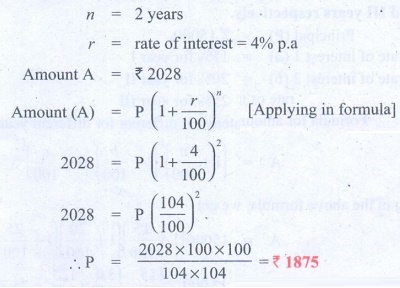
Solution 2:
n = 2 years
r = rate of interest = 4% p.a
Amount A= ₹ 2028
Amount (A) = P ( 1 + [r/100]
)n (Applying in formala]
2028 = P ( 1 + [4/100] )2
2028 = P (104/100)2
∴ P = [ 2028 × 100 × 100] / [104 × 104] =
₹ 1875
6. In how many years will ₹3375 become
₹4096 at 13 1/3 % p.a if the interest is compounded half-yearly?
Solution:
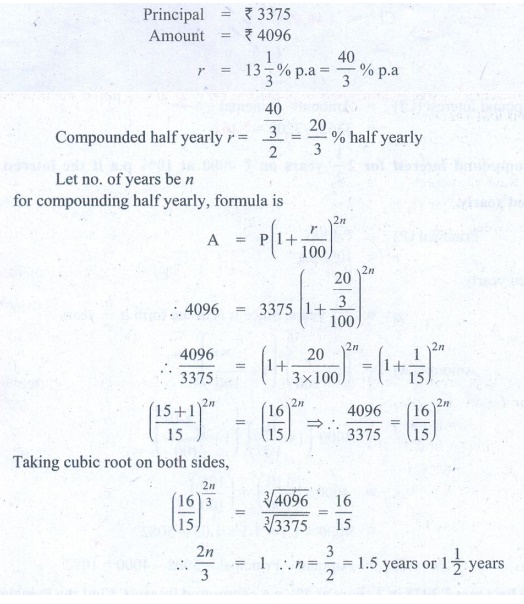
Solution 2:
Principal = ₹ 3375
Amount = ₹ 4096
r = 13 1/3 % p.a = 40/3 % p.a
Compounded half yearly r
= [40/3] / 2 = 20 / 3 % half yearly
Let no. of years be n
for compounding half yearly, formula is
A = P ( 1 + [r/100] )2n
∴ 4096 = 3375 ( 1 + [20/3 / 100] )2n
∴ 4096 / 3375 = (1 + [ 20 / (3×100) ] )2n = (1 + 1/15)2n
( [15 + 1] / 15)2n
= (16/15)2n ⇒ ∴ 4096 / 3375 = (16/15)2n
Taking cubic root on both
sides.
(16/15)2n/3 = 3√4096
/ 3√3375 = 16/15
∴ 2n/3 = 1
∴ n = 3 / 2 = 1.5 years or 1 ½ years
7. Find the C.I on ₹15000 for 3 years
if the rates of interest are 15 % , 20 % and 25 % for the I, II and III years respectively.
Solution:
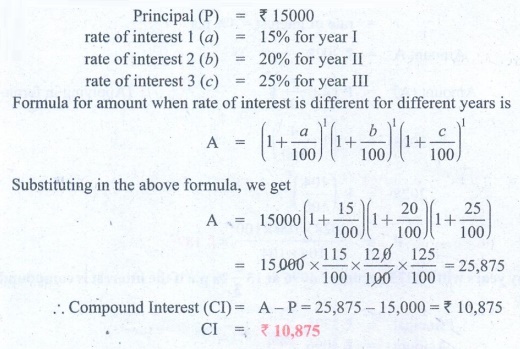
Solution 2:
Principal (P) = ₹ 15000
rate of interest 1 (a) = 15% for year I
rate of interest 2 (b) = 20% for year II
rate of interest 3 (c) = 25% for year III
Formula for amount when rate of interest is different for
different years is
A = (1 + a/100)1 (1 + b/100)1(1
+ c/100)1
Substituting in the above formula, we get
A = 15000 (1 + 15/100) (1 + 20/100) ( 1 + 25/100)
= 15000 × 115/100 × 120/100 × 125/100 = 25,875
Compound Interest (CI) = A – P = 25,875 – 15,000 = ₹ 10,875
CI = ₹ 10,875
8. Find the difference between C.I and
S.I on ₹5000 for 1 year at 2 % p.a, if the interest is compounded half yearly.
Solution:
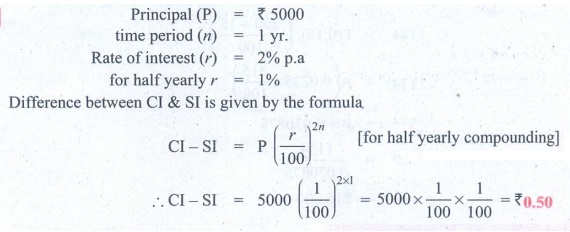
Solution 2:
Principal (P) = ₹ 5000
time period (n) = 1 yr.
Rate of interest (r) = 2% p.a
for half yearly r = 1%
Difference between CI & SI is given by the formula.
CI − SI = P (r/100)2n
[for half yearly compounding]
∴ CI − SI = 5000 (1/100)2x1
= 5000 × 1/100 × 1/100 = ₹ 0.50
9. Find the rate of interest if the difference
between C.I and S.I on ₹8000 compounded annually for 2 years is ₹20.
Solution:
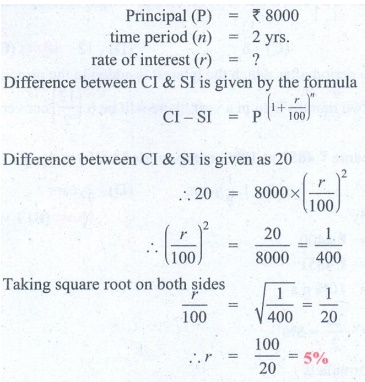
Solution 2:
Principal (P) = ₹ 8000
time period (n) = 2 yrs.
rate of interest (r) = ?
Difference between CI & SI is given by the formula
CI − SI = P (1+r/100)n
Difference between CI & SI is given as 20
∴ 20 = 8000 × (r/100)2
∴ (r/100)2 = 20/8000 = 1/400
Taking square root on both sides
r/100 = √[1/400] = 1/20
∴ r = 100 / 20 = 5%
10. Find the principal if the difference
between C.I and S.I on it at 15 % p.a for 3 years is ₹1134.
Solution:
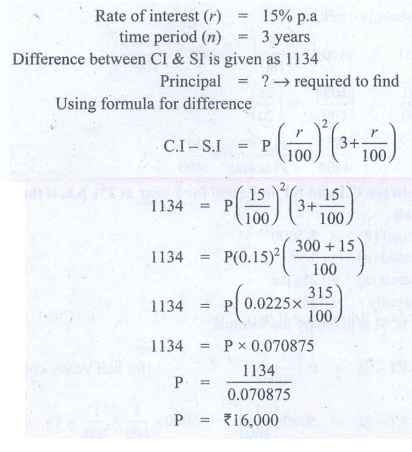
Solution 2:
Rate of interest (r) = 15% p.a
time period (n) =
3 years
Difference between CI & SI is given as 1134
Principal = ? → required to find
Using formula for difference
C.I − S.I = P(r/100)2 (3 + r/100)
1134 = P(15/100)2 (3 + 15/100)
1134 = P(0.15)2 ([300 + 15]/100)
1134 = P (0.0225 × [315/100])
1134 = P × 0.070875
P = 1134/0.070875
P = ₹ 16,000
Objective
Type Questions
11. The number of conversion periods
in a year, if the interest on a principal is compounded every two months is___________.
(A) 2
(B) 4
(C) 6
(D) 12
[Answer: (C) 6]
Solution:
Conversion period is the time period after which the interest is
added to the principal. If principal is compounded every two months then in a
year, there will be 6 (12/2) conversion periods.
12. The time taken for ₹4400 to become
₹4851 at 10 % , compounded half yearly is _______.
(A) 6 months
(B) 1 year
(C) 1 years
(D) 2 years
[Answer: (B) 1 year]
Solution:
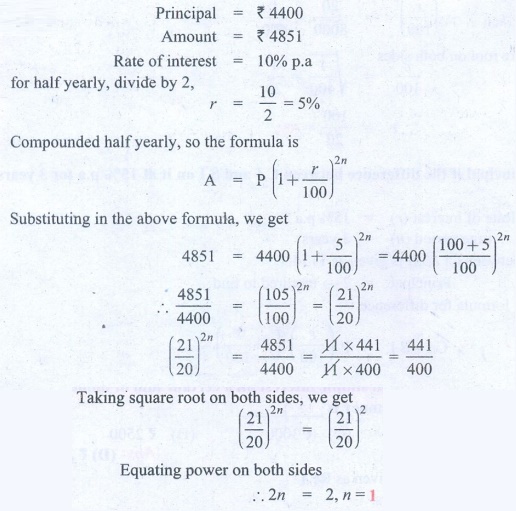
Solution 2:
Principal = ₹ 4400
Amount = ₹ 4851
Rate of interest = 10% p.a
for half yearly, divide by 2,
r = 10/2 = 5%
Compounded half yearly, so the formula is
A = P (1 + [r/100])2n
Substituting in the above formula, we get
4851 = 4400 (1 + [5/100])2n = 4400 ( [100 + 5]
/ 100 )2n
∴ 4851/4400 = (105/100)2n = (21/20)2n
(21/20)2n = 4851/4400 = [11 × 441] / [11 × 400]
= 441/400
Taking square root on both sides, we get
(21/20)2n = (21/20)2
Equating power on both sides
∴ 2n = 2, n = 1
13. The cost of a machine is ₹18000 and
it depreciates at 16 2/3 % annually. Its value after 2 years will be___________.
(A) ₹12000
(B) ₹12500
(C) ₹15000
(D) ₹16500
[Answer: (B) ₹ 12500]
Solution:
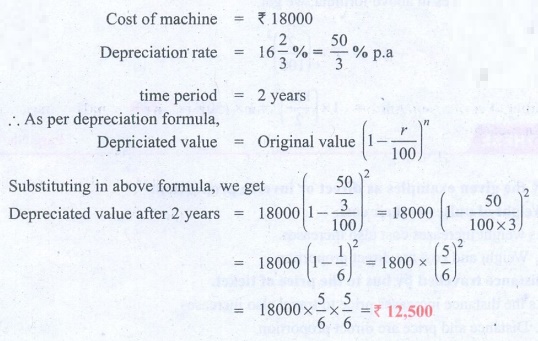
Solution 2:
Cost of machine = ₹ 18000
Depreciation'rate = 16 2/3 % = 50/3 % p.a
time period = 2 years
∴ As per depreciation
formula,
Depriciated value = Original value (1 – r/100]n
Substituting in above formula, we get
Depreciated value after 2 years = 18000 (1 – [(50/3) / 100] )2
= 18000 (1 – [50/ (100 × 3)] )2
= 18000 (1 − 1/6)2 = 18000 × (5/6)2
= 18000 × 5/6 × 5/6 = ₹ 12,500
14. The sum which amounts to ₹2662 at
10 % p.a in 3 years, compounded yearly is_______.
(A) ₹2000
(B) ₹1800
(C) ₹1500
(D) ₹2500
[Answer: (A) ₹ 2000]
Solution:
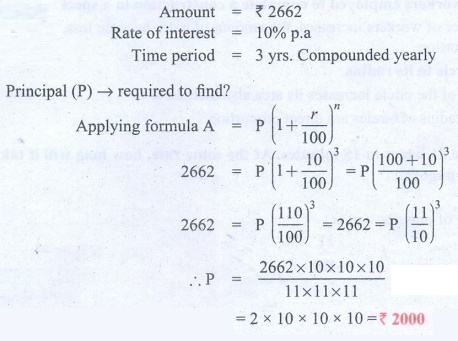
Solution 2:
Amount = ₹ 2662
Rate of interest = 10% p.a
Time period = 3 yrs. Compounded yearly
Principal (P) → required to find?
Applying formula A = P (1 + [r/100])n
2662 = P ( 1 + [10/100] )3 = P ( [100 + 10] / 100 )3
2662 = P (110/100)3 = 2662 = P(11/10)3
∴ P = [ 2662 × 10 × 10
× 10 ] / [ 11 × 11 × 11 ] = 2 × 10 × 10 × 10 = ₹ 2000
15. The difference between compound and
simple interest on a certain sum of money for 2 years at 2 % p.a is ₹1. The sum
of money is __________ .
(A) ₹2000
(B) ₹1500
(C) ₹3000
(D) ₹2500
[Answer: (D) ₹ 2500]
Solution:
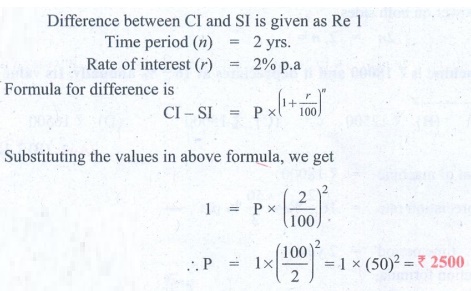
Solution 2:
Difference between CI and SI is given as Re 1
Time period (n) = 2 yrs.
Rate of interest (r) = 2% p.a
Formula for difference is
CI − SI = P × (1 + r/100)n
Substituting the values in above formula, we get
1 = P × (2/100)2
∴ P = 1 × (100/2)2
= 1 × (50)2 = ₹ 2500
Answer:
Exercise 4.3
1. (i) ₹1272 (ii) ₹820
(iii) ₹20,000 (iv) A = P (1 + [r/400])4n (v) ₹32
2. (i) True (ii) False
(iii) True (iv) False (v) True
3. ₹162
4. ₹936.80
5. ₹1875
6. 1 1/2 years
7. ₹10,875
8. ₹0.50
9. 5%
10. ₹ 16000
11. (C) 6
12. (B) 1 year
13. (B) ₹ 12500
14. (A) ₹2000
15. (D) ₹2500
Related Topics